Family
In human society, family (from Latin: familia) is a group of people related either by consanguinity (by recognized birth) or affinity (by marriage or other relationship). The purpose of families is to maintain the well-being of its members and of society. Ideally, families would offer predictability, structure, and safety as members mature and participate in the community.[1] In most societies, it is within families that children acquire socialization for life outside the family. Additionally, as the basic unit for meeting the basic needs of its members, it provides a sense of boundaries for performing tasks in a safe environment, ideally builds a person into a functional adult, transmits culture, and ensures continuity of humankind with precedents of knowledge.
Two parents and a child: the statue Family in the garden of the Palace of Nations, Geneva, Switzerland | ||||||||
| Part of a series on the | ||||||||
| Anthropology of kinship | ||||||||
|---|---|---|---|---|---|---|---|---|
 | ||||||||
|
Basic concepts
|
||||||||
|
Terminology |
||||||||
|
Case studies
|
||||||||
|
Social anthropology Cultural anthropology | ||||||||
Relationships (Outline) |
|---|
|
Endings |
Anthropologists generally classify most family organizations as matrifocal (a mother and her children); patrifocal (a father and his children); conjugal (a wife, her husband, and children, also called the nuclear family); avuncular (for example, a grandparent, a brother, his sister, and her children); or extended (parents and children co-reside with other members of one parent's family).
Members of the immediate family may include spouses, parents, grandparents, brothers, sisters, sons, and daughters. Members of the extended family may include aunts, uncles, cousins, nephews, nieces, and siblings-in-law. Sometimes these are also considered members of the immediate family, depending on an individual's specific relationship with them, and the legal definition of "immediate family" varies.[2] Sexual relations with family members are regulated by rules concerning incest such as the incest taboo.
The field of genealogy aims to trace family lineages through history. The family is also an important economic unit studied in family economics. The word "families" can be used metaphorically to create more inclusive categories such as community, nationhood, and global village.
Social
_und_ihre_Kinder.jpg)

One of the primary functions of the family involves providing a framework for the production and reproduction of persons biologically and socially. This can occur through the sharing of material substances (such as food); the giving and receiving of care and nurture (nurture kinship); jural rights and obligations; and moral and sentimental ties.[4][5] Thus, one's experience of one's family shifts over time. From the perspective of children, the family is a "family of orientation": the family serves to locate children socially and plays a major role in their enculturation and socialization.[6] From the point of view of the parent(s), the family is a "family of procreation", the goal of which is to produce, enculturate and socialize children.[7][8] However, producing children is not the only function of the family; in societies with a sexual division of labor, marriage, and the resulting relationship between two people, it is necessary for the formation of an economically productive household.[9][10][11]
Christopher Harris notes that the western conception of family is ambiguous and confused with the household, as revealed in the different contexts in which the word is used.[12] Olivia Harris states this confusion is not accidental, but indicative of the familial ideology of capitalist, western countries that pass social legislation that insists members of a nuclear family should live together, and that those not so related should not live together; despite the ideological and legal pressures, a large percentage of families do not conform to the ideal nuclear family type.[13]
Size
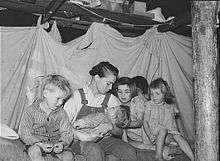
The total fertility rate of women varies from country to country, from a high of 6.76 children born/woman in Niger to a low of 0.81 in Singapore (as of 2015).[14] Fertility is low in most Eastern European and Southern European countries; and high in most Sub-Saharan African countries.[14]
In some cultures, the mother's preference of family size influences that of the children through early adulthood.[15] A parent's number of children strongly correlates with the number of children that their children will eventually have.[16]
Types
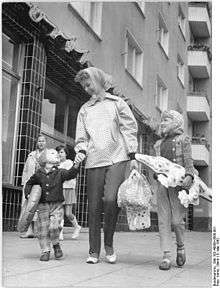
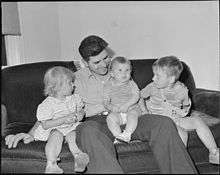
Although early western cultural anthropologists and sociologists considered family and kinship to be universally associated with relations by "blood" (based on ideas common in their own cultures) later research[4] has shown that many societies instead understand family through ideas of living together, the sharing of food (e.g. milk kinship) and sharing care and nurture. Sociologists have a special interest in the function and status of family forms in stratified (especially capitalist) societies.
According to the work of scholars Max Weber, Alan Macfarlane, Steven Ozment, Jack Goody and Peter Laslett, the huge transformation that led to modern marriage in Western democracies was "fueled by the religio-cultural value system provided by elements of Judaism, early Christianity, Roman Catholic canon law and the Protestant Reformation".[17]
Much sociological, historical and anthropological research dedicates itself to the understanding of this variation, and of changes in the family that form over time. Levitan claims:
"Times have changed; it is more acceptable and encouraged for mothers to work and fathers to spend more time at home with the children. The way roles are balanced between the parents will help children grow and learn valuable life lessons. There is [the] great importance of communication and equality in families, in order to avoid role strain."[18]
Conjugal (nuclear) family
The term "nuclear family" is commonly used, especially in the United States of America, to refer to conjugal families. A "conjugal" family includes only the spouses and unmarried children who are not of age.[19] Some sociologists distinguish between conjugal families (relatively independent of the kindred of the parents and of other families in general) and nuclear families (which maintain relatively close ties with their kindred).[20][21] Other family structures - with (for example) blended parents, single parents, and domestic partnerships – have begun to challenge the normality of the nuclear family.[22][23][24]
Single-parent family
A single-parent family consists of one parent together with their children, where the parent is either widowed, divorced (and not remarried), or never married. The parent may have sole custody of the children, or separated parents may have a shared-parenting arrangement where the children divide their time (possibly equally) between two different single-parent families or between one single-parent family and one blended family. As compared to sole custody, physical, mental and social well-being of children may be improved by shared-parenting arrangements and by children having greater access to both parents.[25][26] The number of single-parent families have been increasing, and about half of all children in the United States will live in a single-parent family at some point before they reach the age of 18.[27] Most single-parent families are headed by a mother, but the number of single-parent families headed by fathers is increasing.[28][29][30]
Matrifocal family
A "matrifocal" family consists of a mother and her children. Generally, these children are her biological offspring, although adoption of children is a practice in nearly every society. This kind of family occurs commonly where women have the resources to rear their children by themselves, or where men are more mobile than women. As a definition, "a family or domestic group is matrifocal when it is centred on a woman and her children. In this case, the father(s) of these children are intermittently present in the life of the group and occupy a secondary place. The children's mother is not necessarily the wife of one of the children's fathers."[31]
Extended family

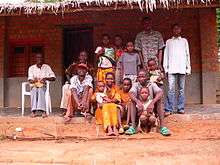
The term "extended family" is also common, especially in the United States. This term has two distinct meanings:
- It serves as a synonym of "consanguinal family" (consanguine means "of the same blood").
- In societies dominated by the conjugal family, it refers to "kindred" (an egocentric network of relatives that extends beyond the domestic group) who do not belong to the conjugal family.
These types refer to ideal or normative structures found in particular societies. Any society will exhibit some variation in the actual composition and conception of families.
Family of choice
The term family of choice, also sometimes referred to as "chosen family" or "found family", is common within the LGBT community, veterans, individuals who have suffered abuse, and those who have no contact with biological "parents". It refers to the group of people in an individual's life that satisfies the typical role of family as a support system. The term differentiates between the "family of origin" (the biological family or that in which people are raised) and those that actively assume that ideal role.[32] The family of choice may or may not include some or all of the members of the family of origin. This terminology stems from the fact that many LGBT individuals, upon coming out, face rejection or shame from the families they were raised in.>[33] The term family of choice is also used by individuals in the 12 step communities, who create close-knit "family" ties through the recovery process.
As a family system, families of choice face unique issues. Without legal safeguards, family's of choice may struggle when medical, educational, or governmental institutions fail to recognize their legitimacy.[33] If members of the chosen family have been disowned by their family of origin, they may experience surrogate grief, displacing anger, loss, or anxious attachment onto their new family.[33]
Blended family
The term blended family or stepfamily describes families with mixed parents: one or both parents remarried, bringing children of the former family into the new family.[34] Also in sociology, particularly in the works of social psychologist Michael Lamb,[35] traditional family refers to "a middle-class family with a bread-winning father and a stay-at-home mother, married to each other and raising their biological children," and nontraditional to exceptions to this rule. Most of the US households are now non-traditional under this definition.[36] Critics of the term "traditional family" point out that in most cultures and at most times, the extended family model has been most common, not the nuclear family,[37] though it has had a longer tradition in England[38] than in other parts of Europe and Asia which contributed large numbers of immigrants to the Americas. The nuclear family became the most common form in the U.S. in the 1960s and 1970s.[39]
In terms of communication patterns in families, there are a certain set of beliefs within the family that reflect how its members should communicate and interact. These family communication patterns arise from two underlying sets of beliefs. One being conversation orientation (the degree to which the importance of communication is valued) and two, conformity orientation (the degree to which families should emphasize similarities or differences regarding attitudes, beliefs, and values).[40]
Monogamous family
A monogamous family is based on a legal or social monogamy. In this case, an individual has only one (official) partner during their lifetime or at any one time (i.e. serial monogamy).[41] This means that a person may not have several different legal spouses at the same time, as this is usually prohibited by bigamy laws, in jurisdictions that require monogamous marriages.
Polygamous family
Polygamy is a marriage that includes more than two partners.[42][43] When a man is married to more than one wife at a time, the relationship is called polygyny; and when a woman is married to more than one husband at a time, it is called polyandry. If a marriage includes multiple husbands and wives, it can be called polyamory,[44] group or conjoint marriage.[43]
Polygyny is a form of plural marriage, in which a man is allowed more than one wife .[45] In modern countries that permit polygamy, polygyny is typically the only form permitted. Polygyny is practiced primarily (but not only) in parts of the Middle East and Africa; and is often associated with Islam, however, there are certain conditions in Islam that must be met to perform polygyny.
Polyandry is a form of marriage whereby a woman takes two or more husbands at the same time.[46] Fraternal polyandry, where two or more brothers are married to the same wife, is a common form of polyandry. Polyandry was traditionally practiced in areas of the Himalayan mountains, among Tibetans in Nepal, in parts of China and in parts of northern India. Polyandry is most common in societies marked by high male mortality or where males will often be apart from the rest of the family for a considerable period of time.[46]
Kinship terminology
Degrees of kinship
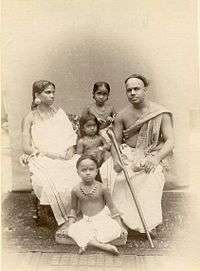
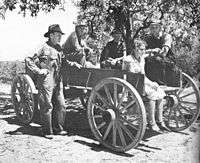
A first-degree relative is one who shares 50% of your DNA through direct inheritance, such as a full sibling, parent or progeny.
There is another measure for the degree of relationship, which is determined by counting up generations to the first common ancestor and back down to the target individual, which is used for various genealogical and legal purposes.
| Kinship | Degree of relationship by coefficient |
Coefficient of relationship |
Degree of relationship by counting generations to common ancestor |
|---|---|---|---|
| identical twins | 0 | 100%[47] | second-degree |
| full sister / full brother | first-degree | 50% (2×2−2) | second-degree |
| mother / father / daughter / son[48] | first-degree | 50% (2−1) | first-degree |
| half-sister / half-brother | second-degree | 25% (2−2) | second-degree |
| grandmother / grandfather / granddaughter / grandson | second-degree | 25% (2−2) | second-degree |
| aunt / uncle / niece / nephew | second-degree | 25% (2×2−3) | third-degree |
| half-aunt / half-uncle / half-niece / half-nephew | third-degree | 12.5% (2−3) | third-degree |
| first cousin | third-degree | 12.5% (2×2−4) | fourth-degree |
| half-first cousin | fourth-degree | 6.25% (2−4) | fourth-degree |
| great-grandmother / great-grandfather / great-granddaughter / great-grandson | third-degree | 12.5% (2−3) | third-degree |
| first cousin once removed | fourth-degree | 6.25% (2⋅2−5) | fifth-degree |
| second cousin | fifth-degree | 3.125% (2−6+2−6) | sixth-degree |
Terminologies
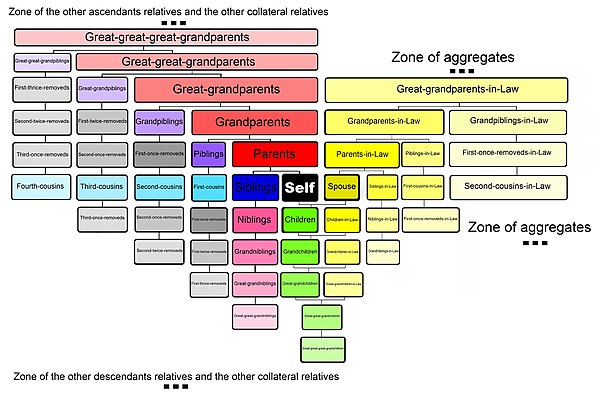
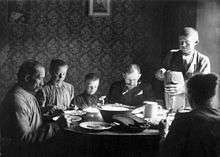
In his book Systems of Consanguinity and Affinity of the Human Family, anthropologist Lewis Henry Morgan (1818–1881) performed the first survey of kinship terminologies in use around the world. Although much of his work is now considered dated, he argued that kinship terminologies reflect different sets of distinctions. For example, most kinship terminologies distinguish between sexes (the difference between a brother and a sister) and between generations (the difference between a child and a parent). Moreover, he argued, kinship terminologies distinguish between relatives by blood and marriage (although recently some anthropologists have argued that many societies define kinship in terms other than "blood").
Morgan made a distinction between kinship systems that use classificatory terminology and those that use descriptive terminology. Classificatory systems are generally and erroneously understood to be those that "class together" with a single term relatives who actually do not have the same type of relationship to ego. (What defines "same type of relationship" under such definitions seems to be genealogical relationship. This is problematic given that any genealogical description, no matter how standardized, employs words originating in a folk understanding of kinship.) What Morgan's terminology actually differentiates are those (classificatory) kinship systems that do not distinguish lineal and collateral relationships and those (descriptive) kinship systems that do. Morgan, a lawyer, came to make this distinction in an effort to understand Seneca inheritance practices. A Seneca man's effects were inherited by his sisters' children rather than by his own children.[49] Morgan identified six basic patterns of kinship terminologies:
- Hawaiian: only distinguishes relatives based upon sex and generation.
- Sudanese: no two relatives share the same term.
- Eskimo: in addition to distinguishing relatives based upon sex and generation, also distinguishes between lineal relatives and collateral relatives.
- Iroquois: in addition to sex and generation, also distinguishes between siblings of opposite sexes in the parental generation.
- Crow: a matrilineal system with some features of an Iroquois system, but with a "skewing" feature in which generation is "frozen" for some relatives.
- Omaha: like a Crow system but patrilineal.
Roles
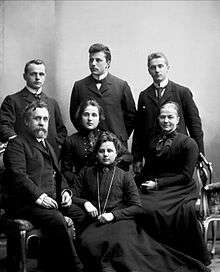

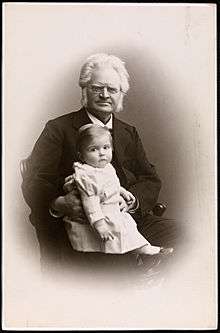


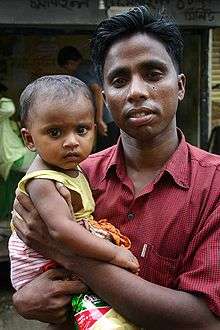
Most Western societies employ Eskimo kinship terminology. This kinship terminology commonly occurs in societies with strong conjugal, where families have a degree of relative mobility. Typically, societies with conjugal families also favor neolocal residence; thus upon marriage, a person separates from the nuclear family of their childhood (family of orientation) and forms a new nuclear family (family of procreation). Such systems generally assume that the mother's husband is also the biological father. The system uses highly descriptive terms for the nuclear family and progressively more classificatory as the relatives become more and more collateral.
Nuclear family
The system emphasizes the nuclear family. Members of the nuclear family use highly descriptive kinship terms, identifying directly only the husband, wife, mother, father, son, daughter, brother, and sister. All other relatives are grouped together into categories. Members of the nuclear family may be lineal or collateral. Kin, for whom these are family, refer to them in descriptive terms that build on the terms used within the nuclear family or use the nuclear family term directly.
Nuclear family of orientation
- Brother: the male child of a parent.
- Sister: the female child of a parent.
- Father: a male parent.
- Grandfather: the father of a parent.
- Mother: a female parent.
- Grandmother: the mother of a parent.
Nuclear conjugal family
- Husband: a male spouse.
- Wife: a female spouse.
- Son: a male child of the parent(s).
- Grandson: a child's son.
- Daughter: a female child of the parent(s).
- Granddaughter: a child's daughter.
Nuclear non-lineal family
- Spouse: husband or wife
- Stepparent: a spouse of a parent that is not a biological parent
- Sibling: sister or brother
- Half-sibling: a sibling with whom the subject shares only one biological parent
- Step-sibling: a child of a parent that is not a biological parent
Collateral relatives
A sibling is a collateral relative with a minimal removal. For collateral relatives with one additional removal, one generation more distant from a common ancestor on one side, more classificatory terms come into play. These terms (Aunt, Uncle, Niece, and Nephew) do not build on the terms used within the nuclear family as most are not traditionally members of the household. These terms do not traditionally differentiate between a collateral relatives and a person married to a collateral relative (both collateral and aggregate). Collateral relatives with additional removals on each side are Cousins. This is the most classificatory term and can be distinguished by degrees of collaterality and by generation (removal).
When only the subject has the additional removal, the relative is the subjects parents siblings, the terms Aunt and Uncle are used for female and male relatives respectively. When only the relative has the additional removal, the relative is the subjects siblings child, the terms Niece and Nephew are used for female and male relatives respectively. The spouse of a biological aunt or uncle is an aunt or uncle, and the nieces and nephews of a spouse are nieces and nephews. With further removal by the subject for aunts and uncles and by the relative for nieces and nephews the prefix "grand-" modifies these terms. With further removal the prefix becomes "great-grand-," adding another "great-" for each additional generation.
When the subject and the relative have an additional removal they are cousins. A cousin with minimal removal is a first cousin, i.e. the child of the subjects uncle or aunt. Degrees of collaterality and removals are used to more precisely describe the relationship between cousins. The degree is the number of generations subsequent to the common ancestor before a parent of one of the cousins is found, while the removal is the difference between the number of generations from each cousin to the common ancestor (the difference between the generations the cousins are from).[50][51]
Cousins of an older generation (in other words, one's parents' first cousins), although technically first cousins once removed, are often classified with "aunts" and "uncles."
Aggregate relatives
English-speakers mark relationships by marriage (except for wife/husband) with the tag "-in-law." The mother and father of one's spouse become one's mother-in-law and father-in-law; the wife of one's son becomes one's daughter-in-law and the husband of one's daughter becomes one's son-in-law. The term "sister-in-law" refers to three essentially different relationships, either the wife of one's brother, or the sister of one's spouse. "Brother-in-law" is the husband of one's sister, or the brother of one's spouse. The terms "half-brother" and "half-sister" indicate siblings who share only one biological parent. The term "aunt-in-law" is the wife of one's uncle, or the aunt of one's spouse. "Uncle-in-law" is the husband of one's aunt, or the uncle of one's spouse. "Cousin-in-law" is the spouse of one's cousin, or the cousin of one's spouse. The term "niece-in-law" is the wife of one's nephew, or the niece of one's spouse. "Nephew-in-law" is the husband of one's niece, or the nephew of one's spouse. The grandmother and grandfather of one's spouse become one's grandmother-in-law and grandfather-in-law; the wife of one's grandson becomes one's granddaughter-in-law and the husband of one's granddaughter becomes one's grandson-in-law.
In Indian English a sibling in law who is the spouse of your sibling can be referred to as a co-sibling (specificity a co-sister[52] or co-brother[53]).
Types of kinship
Patrilineal
Patrilineality, also known as the male line or agnatic kinship, is a form of kinship system in which an individual's family membership derives from and is traced through his or her father's lineage.[54] It generally involves the inheritance of property, rights, names, or titles by persons related through male kin.
A patriline ("father line") is a person's father, and additional ancestors that are traced only through males. One's patriline is thus a record of descent from a man in which the individuals in all intervening generations are male. In cultural anthropology, a patrilineage is a consanguineal male and female kinship group, each of whose members is descended from the common ancestor through male forebears.
Matrilineal
Matrilineality is a form of kinship system in which an individual's family membership derives from and is traced through his or her mother's lineage.
It may also correlate with a societal system in which each person is identified with their matriline—their mother's lineage—and which can involve the inheritance of property and titles. A matriline is a line of descent from a female ancestor to a descendant in which the individuals in all intervening generations are mothers – in other words, a "mother line".
In a matrilineal descent system, an individual is considered to belong to the same descent group as her or his mother. This matrilineal descent pattern is in contrasts to the more common pattern of patrilineal descent pattern.
Bilateral descent
Bilateral descent is a form of kinship system in which an individual's family membership derives from and is traced through both the paternal and maternal sides. The relatives on the mother's side and father's side are equally important for emotional ties or for transfer of property or wealth. It is a family arrangement where descent and inheritance are passed equally through both parents.[55] Families who use this system trace descent through both parents simultaneously and recognize multiple ancestors, but unlike with cognatic descent it is not used to form descent groups.[56]
Traditionally, this is found among some groups in West Africa, India, Australia, Indonesia, Melanesia, Malaysia and Polynesia. Anthropologists believe that a tribal structure based on bilateral descent helps members live in extreme environments because it allows individuals to rely on two sets of families dispersed over a wide area.[57]
History of theories
Early scholars of family history applied Darwin's biological theory of evolution in their theory of evolution of family systems.[58] American anthropologist Lewis H. Morgan published Ancient Society in 1877 based on his theory of the three stages of human progress from Savagery through Barbarism to Civilization.[59] Morgan's book was the "inspiration for Friedrich Engels' book" The Origin of the Family, Private Property and the State published in 1884.[60]
Engels expanded Morgan's hypothesis that economical factors caused the transformation of primitive community into a class-divided society.[61] Engels' theory of resource control, and later that of Karl Marx, was used to explain the cause and effect of change in family structure and function. The popularity of this theory was largely unmatched until the 1980s, when other sociological theories, most notably structural functionalism, gained acceptance.
The nuclear family in industrial society
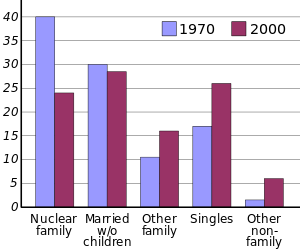
Contemporary society generally views the family as a haven from the world, supplying absolute fulfillment. Zinn and Eitzen discuss the image of the "family as haven ... a place of intimacy, love and trust where individuals may escape the competition of dehumanizing forces in modern society".[63] During industrialization, "[t]he family as a repository of warmth and tenderness (embodied by the mother) stands in opposition to the competitive and aggressive world of commerce (embodied by the father). The family's task was to protect against the outside world."[64] However, Zinn and Eitzen note, "The protective image of the family has waned in recent years as the ideals of family fulfillment have taken shape. Today, the family is more compensatory than protective. It supplies what is vitally needed but missing in other social arrangements."[64]
"The popular wisdom", according to Zinn and Eitzen, sees the family structures of the past as superior to those today, and families as more stable and happier at a time when they did not have to contend with problems such as illegitimate children and divorce. They respond to this, saying, "there is no golden age of the family gleaming at us in the far back historical past."[65] "Desertion by spouses, illegitimate children, and other conditions that are considered characteristics of modern times existed in the past as well."[65]
The postmodern family
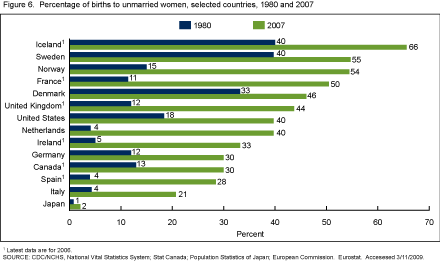
Others argue that whether or not one views the family as "declining" depends on one's definition of "family". "Married couples have dropped below half of all American households. This drop is shocking from traditional forms of the family system. Only a fifth of households were following traditional ways of having married couples raising a family together."[67] In the Western World, marriages are no longer arranged for economic, social or political gain, and children are no longer expected to contribute to family income. Instead, people choose mates based on love. This increased role of love indicates a societal shift toward favoring emotional fulfilment and relationships within a family, and this shift necessarily weakens the institution of the family.[68]
Margaret Mead considers the family as a main safeguard to continuing human progress. Observing, "Human beings have learned, laboriously, to be human", she adds: "we hold our present form of humanity on trust, [and] it is possible to lose it" ... "It is not without significance that the most successful large-scale abrogations of the family have occurred not among simple savages, living close to the subsistence edge, but among great nations and strong empires, the resources of which were ample, the populations huge, and the power almost unlimited"[69]
Many countries (particularly Western) have, in recent years, changed their family laws in order to accommodate diverse family models. For instance, in the United Kingdom, in Scotland, the Family Law (Scotland) Act 2006 provides cohabitants with some limited rights.[70] In 2010, Ireland enacted the Civil Partnership and Certain Rights and Obligations of Cohabitants Act 2010. There have also been moves at an international level, most notably, the Council of Europe European Convention on the Legal Status of Children Born out of Wedlock[71] which came into force in 1978. Countries which ratify it must ensure that children born outside marriage are provided with legal rights as stipulated in the text of this Convention. The Convention was ratified by the UK in 1981 and by Ireland in 1988.[72]
In the United States, one in five mothers has children by different fathers; among mothers with two or more children the figure is higher, with 28% having children with at least two different men. Such families are more common among Blacks and Hispanics and among the lower socioeconomic class.[73]
However, in western society, the single parent family has been growing more accepted and has begun to make an impact on culture. Single parent families are more commonly single mother families than single father. These families sometimes face difficult issues besides the fact that they have to rear their children on their own, for example, low income making it difficult to pay for rent, child care, and other necessities for a healthy and safe home.
Domestic violence
Domestic violence (DV) is violence that happens within the family. The legal and social understanding of the concept of DV differs by culture. The definition of the term "domestic violence" varies, depending on the context in which it is used.[74] It may be defined differently in medical, legal, political or social contexts. The definitions have varied over time, and vary in different parts of the world.
The Convention on preventing and combating violence against women and domestic violence states that:[75]
- " “domestic violence” shall mean all acts of physical, sexual, psychological or economic violence that occur within the family or domestic unit or between former or current spouses or partners, whether or not the perpetrator shares or has shared the same residence with the victim".
In 1993, the United Nations Declaration on the Elimination of Violence against Women identified domestic violence as one of three contexts in which violence against women occurs, describing it as:[76]
- "Physical, sexual and psychological violence occurring in the family, including battering, sexual abuse of female children in the household, dowry-related violence, marital rape, female genital mutilation and other traditional practices harmful to women, non-spousal violence and violence related to exploitation".
Family violence
Family violence is a broader definition, often used to include child abuse, elder abuse, and other violent acts between family members.[77]
Child abuse is defined by the WHO as:[78]
- "Child maltreatment, sometimes referred to as child abuse and neglect, includes all forms of physical and emotional ill-treatment, sexual abuse, neglect, and exploitation that results in actual or potential harm to the child’s health, development or dignity. Within this broad definition, five subtypes can be distinguished – physical abuse; sexual abuse; neglect and negligent treatment; emotional abuse; and exploitation." There exists legislation to prevent and punish the occurrence of these offences. There are laws regarding familial sexual activity, which states that it is a criminal offence to have any kind of sexual relationship between one's grandparent, parent, sibling, aunt or uncle.[79][80]
Elder abuse is, according to the WHO: "a single, or repeated act, or lack of appropriate action, occurring within any relationship where there is an expectation of trust which causes harm or distress to an older person".[81]
Parental abuse of children (child abuse)
Child abuse is the physical, sexual or emotional maltreatment or neglect of a child or children.[82] In the United States, the Centers for Disease Control and Prevention (CDC) and the Department for Children and Families (DCF) define child maltreatment as any act or series of acts of commission or omission by a parent or other caregiver that results in harm, potential for harm, or threat of harm to a child.[83] Child abuse can occur in a child's home, or in the organizations, schools or communities the child interacts with. There are four major categories of child abuse: neglect, physical abuse, psychological or emotional abuse, and sexual abuse.
Parental abuse by children
Abuse of parents by their children is a common but under reported and under researched subject. Parents are quite often subject to levels of childhood aggression in excess of normal childhood aggressive outbursts, typically in the form of verbal or physical abuse. Parents feel a sense of shame and humiliation to have that problem, so they rarely seek help and there is usually little or no help available anyway.[84][85]
Elder abuse
Elder abuse is "a single, or repeated act, or lack of appropriate action, occurring within any relationship where there is an expectation of trust, which causes harm or distress to an older person."[86] This definition has been adopted by the World Health Organization from a definition put forward by Action on Elder Abuse in the UK. Laws protecting the elderly from abuse are similar to, and related to, laws protecting dependent adults from abuse.
The core element to the harm of elder abuse is the "expectation of trust" of the older person toward their abuser. Thus, it includes harms by people the older person knows or with whom they have a relationship, such as a spouse, partner or family member, a friend or neighbor, or people that the older person relies on for services. Many forms of elder abuse are recognized as types of domestic violence or family violence.
Forced and child marriage
Forced and child marriages are practiced in certain regions of the world, particularly in Asia and Africa, and these types of marriages are associated with a high rate of domestic violence.[87][88][89][90]
A forced marriage is a marriage where one or both participants are married without their freely given consent.[91] The line between forced marriage and consensual marriage may become blurred, because the social norms of many cultures dictate that one should never oppose the desire of one's parents/relatives in regard to the choice of a spouse; in such cultures it is not necessary for violence, threats, intimidation etc. to occur, the person simply "consents" to the marriage even if he/she doesn't want it, out of the implied social pressure and duty. The customs of bride price and dowry, that exist in parts of the world, can lead to buying and selling people into marriage.[92][93]
A child marriage is a marriage where one or both spouses are under 18.[94][87] Child marriage was common throughout history but is today condemned by international human rights organizations.[95][96][97] Child marriages are often arranged between the families of the future bride and groom, sometimes as soon as the girl is born.[95] Child marriages can also occur in the context of marriage by abduction.[95]
The concept of family honour
Family honor is an abstract concept involving the perceived quality of worthiness and respectability that affects the social standing and the self-evaluation of a group of related people, both corporately and individually.[98][99] The family is viewed as the main source of honor and the community highly values the relationship between honor and the family.[100] The conduct of family members reflects upon family honor and the way the family perceives itself, and is perceived by others.[99] In cultures of honor maintaining the family honor is often perceived as more important than either individual freedom, or individual achievement.[101] In extreme cases, engaging in acts that are deemed to tarnish the honor of the family results in honor killings. An honor killing is the homicide of a member of a family or social group by other members, due to the perpetrators' belief that the victim has brought shame or dishonor upon the family or community, usually for reasons such as refusing to enter an arranged marriage, being in a relationship that is disapproved by their relatives, having sex outside marriage, becoming the victim of rape, dressing in ways which are deemed inappropriate, or engaging in homosexual relations.[102][103][104][105][106]
Economic issues
A family is often part of a sharing economy with common ownership.
Dowry, bride price and dower

Dowry is property (money, goods, or estate) that a wife or wife's family gives to her husband when the wife and husband marry.[107] Offering dowry was common in many cultures historically (including in Europe and North America), but this practice today is mostly restricted to some areas primarily in the Indian subcontinent.
Bride price, (also bridewealth or bride token), is property paid by the groom or his family to the parents of a woman upon the marriage of their daughter to the groom. It is practiced mostly in Sub-Saharan Africa, parts of South-East Asia (Thailand, Cambodia), and parts of Central Asia.
Dower is property given to the bride herself by the groom at the time of marriage, and which remains under her ownership and control.[108]
Property regimes and taxation
In some countries married couples benefit from various taxation advantages not available to a single person or to unmarried couples. For example, spouses may be allowed to average their combined incomes. Some jurisdictions recognize common law marriage or de facto relations for this purposes. In some jurisdictions there is also an option of civil partnership or domestic partnership.
Different property regimes exist for spouses. In many countries, each marriage partner has the choice of keeping their property separate or combining properties. In the latter case, called community property, when the marriage ends by divorce each owns half. In lieu of a will or trust, property owned by the deceased generally is inherited by the surviving spouse.
Rights and laws
Reproductive rights
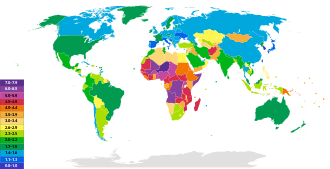
Reproductive rights are legal rights and freedoms relating to reproduction and reproductive health. These include the right to decide on issues regarding the number of children born, family planning, contraception, and private life, free from coercion and discrimination; as well as the right to access health services and adequate information.[109][110][111][112] According to UNFPA, reproductive rights "include the right to decide the number, timing and spacing of children, the right to voluntarily marry and establish a family, and the right to the highest attainable standard of health, among others".[113] Family planning refers to the factors that may be considered by individuals and couples in order for them to control their fertility, anticipate and attain the desired number of children and the spacing and timing of their births.[114][115]
The state and church have been, and still are in some countries, involved in controlling the size of families, often using coercive methods, such as bans on contraception or abortion (where the policy is a natalist one—for example through tax on childlessness) or conversely, discriminatory policies against large families or even forced abortions (e.g., China's one-child policy in place from 1978 to 2015). Forced sterilization has often targeted ethnic minority groups, such as Roma women in Eastern Europe,[116][117] or indigenous women in Peru (during the 1990s).[118]
Parents' rights
The parents' rights movement is a movement whose members are primarily interested in issues affecting parents and children related to family law, specifically parental rights and obligations. Mothers' rights movements focus on maternal health, workplace issues such as labor rights, breastfeeding, and rights in family law. The fathers' rights movement is a movement whose members are primarily interested in issues related to family law, including child custody and child support, that affect fathers and their children.[119]
Children's rights
Children's rights are the human rights of children, with particular attention to the rights of special protection and care afforded to minors, including their right to association with both parents, their right to human identity, their right to be provided in regard to their other basic needs, and their right to be free from violence and abuse.[120][121][122]
Marriage rights
Each jurisdiction has its own marriage laws. These laws differ significantly from country to country; and these laws are often controversial. Areas of controversy include women's rights as well as same-sex marriage.
Legal reforms
Legal reforms to family laws have taken place in many countries during the past few decades. These dealt primarily with gender equality within marriage and with divorce laws. Women have been given equal rights in marriage in many countries, reversing older family laws based on the dominant legal role of the husband. Coverture, which was enshrined in the common law of England and the US for several centuries and throughout most of the 19th century, was abolished. In some European countries the changes that lead to gender equality were slower. The period of 1975–1979 saw a major overhaul of family laws in countries such as Italy,[123][124] Spain,[125] Austria,[126][126] West Germany,[127][128] and Portugal.[129] In 1978, the Council of Europe passed the Resolution (78) 37 on equality of spouses in civil law.[130] Among the last European countries to establish full gender equality in marriage were Switzerland. In 1985, a referendum guaranteed women legal equality with men within marriage.[131][132] The new reforms came into force in January 1988.[133] In Greece, in 1983, legislation was passed guaranteeing equality between spouses, abolishing dowry, and ending legal discrimination against illegitimate children.[134][135] In 1981, Spain abolished the requirement that married women must have their husbands’ permission to initiate judicial proceedings[136] the Netherlands,[137][138] and France[139] in the 1980s. In recent decades, the marital power has also been abolished in African countries that had this doctrine, but many African countries that were former French colonies still have discriminatory laws in their marriages regulations, such regulations originating in the Napoleonic Code that has inspired these laws.[136] In some countries (predominantly Roman Catholic) divorce was legalized only recently (e.g. Italy (1970), Portugal (1975), Brazil (1977), Spain (1981), Argentina (1987), Ireland (1996), Chile (2004) and Malta (2011)) although annulment and legal separation were options. Philippines still does not allow divorce. (see Divorce law by country). The laws pertaining to the situation of children born outside marriage have also been revised in many countries (see Legitimacy (family law)).
Health

Family medicine
Family medicine is a medical specialty devoted to comprehensive health care for people of all ages; it is based on knowledge of the patient in the context of the family and the community, emphasizing disease prevention and health promotion.[141] The importance of family medicine is being increasingly recognized.[142]
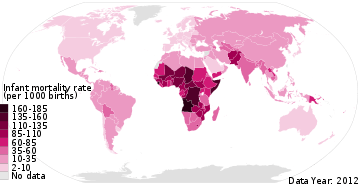
Maternal mortality
Maternal mortality or maternal death is defined by WHO as "the death of a woman while pregnant or within 42 days of termination of pregnancy, irrespective of the duration and site of the pregnancy, from any cause related to or aggravated by the pregnancy or its management but not from accidental or incidental causes."[144] Historically, maternal mortality was a major cause of women's death. In recent decades, advances in healthcare have resulted in rates of maternal mortality having dropped dramatically, especially in Western countries. Maternal mortality however remains a serious problem in many African and Asian counties.[144][145]
Infant and child mortality
Infant mortality is the death of a child less than one year of age. Child mortality is the death of a child before the child's fifth birthday. Like maternal mortality, infant and child mortality were common throughout history, but have decreased significantly in modern times.[146][147]
Politics
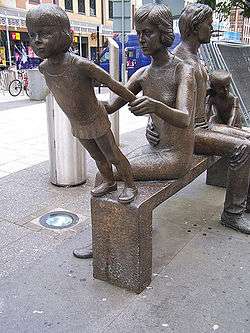
While in many parts of the world family policies seek to promote a gender-equal organization of the family life, in others the male-dominated family continues to be the official policy of the authorities, which is also supported by law. For instance, the Civil Code of Iran states at Article 1105: "In relations between husband and wife; the position of the head of the family is the exclusive right of the husband".[148]
In some parts of the world, some governments promote a specific form of family, such as that based on traditional family values. The term "family values" is often used in political discourse in some countries, its general meaning being that of traditional or cultural values that pertain to the family's structure, function, roles, beliefs, attitudes, and ideals, usually involving the "traditional family"—a middle-class family with a breadwinner father and a homemaker mother, raising their biological children. Any deviation from this family model is considered a "nontraditional family".[149] These family ideals are often advanced through policies such as marriage promotion. Some jurisdictions outlaw practices which they deem as socially or religiously unacceptable, such as fornication, cohabitation or adultery.
Work-family balance
Work-family balance is a concept involving proper prioritizing between work/career and family life. It includes issues relating to the way how work and families intersect and influence each other. At a political level, it is reflected through policies such maternity leave and paternity leave. Since the 1950s, social scientists as well as feminists have increasingly criticized gendered arrangements of work and care, and the male breadwinner role, and policies are increasingly targeting men as fathers, as a tool of changing gender relations.[150]
Protection of private and family life
Article 8 of the European Convention on Human Rights provides a right to respect for one's "private and family life, his home and his correspondence", subject to certain restrictions that are "in accordance with law" and "necessary in a democratic society".[151]
Article 8 – Right to respect for private and family life
1. Everyone has the right to respect for his private and family life, his home and his correspondence.
2. There shall be no interference by a public authority with the exercise of this right except such as is in accordance with the law and is necessary in a democratic society in the interests of national security, public safety or the economic well-being of the country, for the prevention of disorder or crime, for the protection of health or morals, or for the protection of the rights and freedoms of others.
Criticism
Certain social scientists have advocated the abolition of the family. An early opponent of the family was Socrates whose position was outlined by Plato in The Republic.[152] In Book 5 of The Republic, Socrates tells his interlocutors that a just city is one in which citizens have no family ties.[153][154]
The family being such a deep-rooted and much-venerated institution, few intellectuals have ventured to speak against it. Familialism has been atypically defined as a "social structure where ... a family's values are held in higher esteem than the values of the individual members of the family." Favoritism granted to relatives regardless of merit is called nepotism.
The Russian-American rationalist and individualist philosopher, novelist and playwright Ayn Rand compared partiality towards consanguinity with racism, as a small-scale manifestation of the latter.[155] "The worship of the family is merely racism, like a crudely primitive first installment on the worship of the tribe. It places the accident of birth above a man's values and duty to the tribe above a man's right to his own life."[156] Additionally, she spoke in favor of childfree lifestyle, while following it herself.[155]
The British social critic, poet, mountaineer and occultist Aleister Crowley censured the institution of family in his works: "Horrid word, family! Its very etymology accuses it of servility and stagnation. / Latin, famulus, a servant; Oscan, Faamat, he dwells. ... [T]hink what horrid images it evokes from the mind. Not only Victorian; wherever the family has been strong, it has always been an engine of tyranny. Weak members or weak neighbours: it is the mob spirit crushing genius, or overwhelming opposition by brute arithmetic. ... In every Magical, or similar system, it is invariably the first condition which the Aspirant must fulfill: he must once and for all and for ever put his family outside his magical circle."[157]
The family and social justice
One of the controversies regarding the family is the application of the concept of social justice to the private sphere of family relations, in particular with regard to the rights of women and children. Throughout much of the history, most philosophers who advocated for social justice focused on the public political arena, not on the family structures; with the family often being seen as a separate entity which needed to be protected from outside state intrusion. One notable exception was John Stuart Mill, who, in his work The Subjection of Women, advocated for greater rights for women within marriage and family.[158] Second wave feminists argued that the personal is political, stating that there are strong connections between personal experiences and the larger social and political structures. In the context of the feminist movement of the 1960s and 1970s, this was a challenge to the nuclear family and family values, as they were understood then.[159] Feminists focused on domestic violence, arguing that the reluctance—in law or in practice—of the state to intervene and offer protection to women who have been abused within the family, is in violation of women's human rights, and is the result of an ideology which places family relations outside the conceptual framework of human rights.[160]
Global trends in family composition
Statistics from an infographic by Olivier Ballou showed that,[161]
In 2013, just over 40% of US babies were born outside marriage. The Census bureau estimated that 27% of all children lived in a fatherless home. Europe has seen a surge in child-free adults. One in five 40-something women are childless in Sweden and in Switzerland, in Italy one in four, in Berlin one in three. So-called traditional societies are seeing the same trend. About one-sixth of Japanese women in their forties have never married and about 30% of all woman that age are childless.
However, Swedish statisticians reported in 2013 that, in contrast to many countries, since the 2000s, fewer children have experienced their parents' separation, childlessness had decreased in Sweden and marriages had increased. It had also become more common for couples to have a third child suggesting that the nuclear family was no longer in decline in Sweden.[162]:10
See also
References
Citations
- Donald Collins; Catheleen Jordan; Heather Coleman (2010). An Introduction to Family Social Work. Brooks/Cole, Cengage Learning. pp. 28–29. ISBN 978-0-495-80872-5.
- "Immediate Family Law and Legal Definition | USLegal, Inc". definitions.uslegal.com. Retrieved 2020-02-04.
- Jás Elsner (2007). "The Changing Nature of Roman Art and the Art Historical Problem of Style," in Eva R. Hoffman (ed), Late Antique and Medieval Art of the Medieval World, 11–18. Oxford, Malden & Carlton: Blackwell Publishing. ISBN 978-1-4051-2071-5, p. 17, Figure 1.3 on p. 18.
- Schneider, David 1984 A Critique of the Study of Kinship. Ann Arbor: University of Michigan Press. p. 182
- Deleuze-Guattari (1972). Part 2, ch. 3, p. 80
- Russon, John, (2003) Human Experience: Philosophy, Neurosis, and the Elements of Everyday Life, Albany: State University of New York Press. pp. 61–68.
- George Peter Murdoch Social Structure p. 13
- Shyam, Radhey (2009). Clinical Child Psychology. Delhi: Gyan Books. pp. 113–115. ISBN 978-81-7835-761-4.
- Wolf, Eric. 1982 Europe and the People Without History. Berkeley: University of California Press. 92
- Harner, Michael 1975 "Scarcity, the Factors of Production, and Social Evolution," in Population, Ecology, and Social Evolution, Steven Polgar, ed. Mouton Publishers: the Hague.
- Rivière, Peter 1987 "Of Women, Men, and Manioc", Etnologiska Studier (38).
- "We have seen that people can refer to their relatives as 'the family.' 'All the family turned up for the funeral... But of course, my brother didn't bring his family along— they're much too young.' Here the reference is to the offspring (as distinct from 'all' the family). The neighbors were very good, too. 'The Jones came, and their two children. It was nice, the whole family turning up like that.' Here the usage is more restricted than 'relatives' or 'his relatives,' but includes just both parents and offspring. 'Of course, the children will be leaving home soon. It's always sad to see the family break up like that.' Here the reference is not only to parents and children but to their co-residence, that is, to the household."The Family and Industrial Society", 1983, George Allen Unwin, London, p. 30
- Olivia Harris. Kate Young; Carol Wolkowitz; Roslyn McCullagh (eds.). Of Marriage and the Market: Women's Subordination Internationally and its Lessons. London: Routeledge. p. 138.
- "The World Factbook – Central Intelligence Agency". Cia.gov. Retrieved 12 April 2017.
- Axinn, William G.; Clarkberg, Marin E.; Thornton, Arland (1994). "Family Influences on Family Size Preferences". Demography. 31 (1): 65–79. doi:10.2307/2061908. ISSN 0070-3370. JSTOR 2061908. PMID 8005343.
- Murphy, Michael (2013). "Cross-National Patterns of Intergenerational Continuities in Childbearing in Developed Countries". Biodemography and Social Biology. 59 (2): 101–126. doi:10.1080/19485565.2013.833779. ISSN 1948-5565. PMC 4160295. PMID 24215254.
- "The Collapse of Marriage by Don Browning – The Christian Century". Religion-online.org. February 7, 2006. pp. 24–28. Archived from the original on September 30, 2007. Retrieved 2007-07-10.
- Levitan, Sara (2010). "Working wives and mothers: what happens to family life?" (PDF). Retrieved January 8, 2014.
- Smith, Court. "Definitions of Anthropological Terms". Oregonstate.edu. Retrieved 12 April 2017.
-
Compare:
Scott, John, ed. (2014). A Dictionary of Sociology. Oxford paperback reference (4 ed.). Oxford: Oxford University Press. p. 237. ISBN 978-0-19-968358-1. Retrieved 2018-06-30.
The conjugal family refers to a family system of spouses and their dependent children. [...] The term nuclear family is used to refer to a unit consisting of spouses and their dependent children. [...]
-
Compare:
Lee, Gary R. (1999). "4: Comparative Perspectives". In Sussman, Marvin B.; Steinmetz, Suzanne K.; Peterson, Gary W. (eds.). Handbook of Marriage and the Family (2 ed.). New York: Springer Science & Business Media (published 2013). p. 96. ISBN 978-1-4757-5367-7. Retrieved 2018-06-30.
[...] the nuclear family (consisting of parents and dependent children) [...] the conjugal family (defined as nuclear in structure) [...].
- "Fewer than half of U.S. kids today live in a 'traditional' family". Pewresearch.org. 22 December 2014. Retrieved 12 April 2017.
- Staff writers (March 2014). "The Kids will be alright, even without the Nuclear Family". Pacific Standard magazine. Retrieved 22 April 2017.
- Bryant, L.E. (March 2016). "Nuclear Families". The Wiley-Blackwell Encyclopedia of Family Studies. pp. 1–3. doi:10.1002/9781119085621.wbefs490. ISBN 978-0-470-65845-1.
- Sanford L. Braver and Michael E. Lamb, Shared Parenting After Parental Separation: The Views of 12 Experts, Journal of Divorce & Remarriage, April 2018 - "The empirical evidence currently available supports the view that children of divorce, on average, benefit substantially from SP [shared parenting] arrangements in which they live with each parent at least 35% of the time. Findings from well over 50 individual studies indicate that children whose parents have SP fare better than those with sole physical custody [...]."
- Baude, Amandine; Pearson, Jessica; Drapeau, Sylvie (27 June 2016). "Child Adjustment in Joint Physical Custody Versus Sole Custody: A Meta-Analytic Review". Journal of Divorce & Remarriage. 57 (5): 338–360. doi:10.1080/10502556.2016.1185203.
- Tish Davidson, Single-parent families, Encyclopedia of Children's Health - "One out of every two children in the United States will live in a single-parent family at some time before they reach age 18."
- Tish Davidson, Single-parent families, Encyclopedia of Children's Health - "The most common type of single-parent family is one that consists of a mother and her biological children. [...] Households headed by a single father increased substantially after the early 1980s [...]."
- American Psychological Association, Single parenting and today's family
- Kathryn M. Feltey, Single-Parent Families, International Encyclopedia of Marriage and Family
- Godelier, Maurice, trans. Nora Scott, The Metamorphoses of Kinship (London: Verso, 2011 (ISBN 978-1-84467-746-7)), p. 568 (Glossary, entry matrifocal) (trans. from Métamorphoses de la parenté (Librarie Arthème Fayard (apparently), 2004)) (author prof. anthropology, École des hautes études en sciences sociales, Paris).
- "ALGBTICAL LGBT Glossary of Terminology". ALGBTICAL Association for Lesbian, Gay, Bisexual, and Transgender Issues in Counseling of Alabama. 2005–2006. Retrieved May 4, 2016.
- Stitt, Alex (2020). ACT For Gender Identity: The Comprehensive Guide. London: Jessica Kingsley Publishers. pp. 372–376. ISBN 978-1785927997. OCLC 1089850112.
- Blended and Blessed – Encouraging Step-Families, blendedandblessed.com
- "Department of Social and Developmental Psychology: PPSIS Faculty, Academic Profile". Sdp.cam.ac.uk. Archived from the original on 2011-11-25. Retrieved 2011-03-26.
- Civil Action No. 1:09-cv-10309 Archived 2010-12-25 at the Wayback Machine paragraph 17
- Parenting Myths And Facts
- see History of the family § Evolution of household
- History of Nuclear Families
- McCornack, Steven (2010). Reflect & Relate an introduction to interpersonal communication. Boston/NY: Bedford/St. Martin's. pp. 369–370.
- Cf. "Monogamy" in Britannica World Language Dictionary, R.C. Preble (ed.), Oxford-London 1962, p. 1275:1. The practice or principle of marrying only once. opp. to digamy now rare 2. The condition, rule or custom of being married to only one person at a time (opp. to polygamy or bigamy) 1708. 3. Zool. The habit of living in pairs, or having only one mate; The same text repeats The Shorter Oxford English Dictionary, W. Little, H.W. Fowler, J. Coulson (ed.), C.T. Onions (rev. & ed.,) Oxford 1969, 3rd edition, vol. 1, p. 1275; OED Online. March 2010. Oxford University Press. 23 Jun. 2010 Cf. Monogamy in Merriam-Webster Dictionary
- "Opening Up: Challenging Myths about Consensual Non-Monogamy – Science of Relationships". Scienceofrelationships.com. 2012-08-17. Retrieved 12 April 2017.
- Zeitzen, Miriam Koktvedgaard (2008). Polygamy: a cross-cultural analysis. Berg. p. 3. ISBN 978-1-84520-220-0.
- McCullough, Derek; Hall, David S. (February 27, 2003). "Polyamory – What it is and what it isn't". Electronic Journal of Human Sexuality. 6.CS1 maint: ref=harv (link)
- Zeitzen, Miriam K. (2008). Polygamy: A Cross-Cultural Analysis. Oxford: Berg. p. 9.
- Starkweather, Katherine E.; Hames, Raymond (June 2012). "A survey of non-classical polyandry". Human Nature. 23 (2): 149–172. doi:10.1007/s12110-012-9144-x. PMID 22688804.CS1 maint: ref=harv (link)
- By replacement in the definition of the notion of "generation" by meiosis". Since identical twins are not separated by meiosis, there are no "generations" between them, hence n=0 and r=1. See genetic-genealogy.co.uk.
- "Kin Selection". Benjamin/Cummings. Retrieved 2007-11-25.
- Tooker, Elisabeth. "Another View of Morgan on Kinship." Current Anthropology 20, no. 1 (March 1979): 131–134.
- "A Dictionary of Genetics". A Dictionary of Genetics. Oxford University Press. 2013. 8.
- "Definition of Cousin by Merriam-Webster". merriam-webster.com. Merriam-Webster.
- "Co-Sister". Cambridge Dictionary. Cambridge Dictionary. Retrieved 18 April 2020.
- "Co-Brother". Cambridge Dictionary. Cambridge Dictionary. Retrieved 18 April 2020.
- Benokraitis, N.V. Marriages and Families. 7th Edition, Pearson Education, Inc., 2011
- Shepard, Jon; Greene, Robert W. (2003). Sociology and You. Ohio: Glencoe McGraw-Hill. p. A-22. ISBN 978-0-07-828576-9. Archived from the original on 2010-03-08.
- Stone, Linda (2006). Kinship and Gender: An Introduction. Boulder, Colorado: Westview Press. pp. 168–169. ISBN 978-0-8133-4302-0.
- Ezzell, Carol (June 2001). "The Himba and the Dam". Scientific American. 284 (6): 80–90. doi:10.1038/scientificamerican0601-80. PMID 11396346. Archived from the original on 2007-10-12. Retrieved 2015-07-12.
- "Sociology/Founding the discipline". Encyclopædia Britannica. Retrieved 2009-07-26.
- Morgan 1877
- "Cultural Anthropology". Encyclopædia Britannica. Retrieved 2009-07-22.
- "The Marxists Internet Archive". Retrieved 2009-07-17.
- Williams, Brian; Sawyer, Stacey C.; Wahlstrom, Carl M. (2005). Marriages, Families & Intimate Relationships. Boston, MA: Pearson. 0-205-36674-0.
-
Zinn, Maxine Baca; Eitzen, D. Stanley (2002). Diversity in families (6 ed.). Allyn and Bacon. p. 557. ISBN 978-0-205-33522-0. Retrieved 2012-01-06.
This 'family as haven' image of a refuge from an impersonal world characterizes the family as a place of intimacy, love, and trust in which individuals may escape the competition of dehumanizing forces in modern society. Christopher Lasch (1977:8) has named this image a 'haven in a heartless world' and described it as a glorification of private life made necessary by the deprivations experienced in the public world.
- Zinn and Eitzen (1987) Diversity in American families, p. 3
- Zinn and Eitzen (1987) Diversity in American families, p. 8
- "Changing Patterns of Nonmarital Childbearing in the United States". CDC/National Center for Health Statistics. May 13, 2009. Retrieved September 24, 2011.
- Tavernise, Sabrina (2011). "Married Couples Are No Longer a Majority, Census Finds". Retrieved January 8, 2014.
- Coontz, Stephanie. 2005. Marriage, A History: How Love Conquered Marriage. New York: Viking/Penguin Books.
- Male and Female, New York, 1949. pp. 193–194
- ceu@scotland.gsi.gov.uk, Scottish Government, Edinburgh (27 April 2006). "Family Matters – Couples – Cohabitation". Scotland.gov.uk. Retrieved 12 April 2017.
- "Full list". Coe.int. Retrieved 12 April 2017.
- "Full list". Coe.int. Retrieved 12 April 2017.
- "1 in 5 US moms have kids with multiple dads, study says". Nbcnews.com. 1 April 2011. Retrieved 12 April 2017.
- "Definitions of Domestic Violence – Child Welfare Information Gateway". Childwelfare.gov. Archived from the original on 15 December 2014. Retrieved 23 October 2017.
- "Full list". Coe.int. Retrieved 12 April 2017.
- "A/RES/48/104. Declaration on the Elimination of Violence against Women". United Nations. 20 December 1993.
- Wallace, p. 2
- "Child maltreatment". World Health Organization. Retrieved 23 October 2017.
- Roffee, James A. (2015). "When Yes Actually Means Yes". Roffee, James (2015). When Yes Actually Means Yes in Rape Justice. 72–91. doi:10.1057/9781137476159.0009. ISBN 978-1-137-47615-9.
- Roffee, J. A. (2014). "No Consensus on Incest? Criminalisation and Compatibility with the European Convention on Human Rights" (PDF). Human Rights Law Review. 14 (3): 541–572. doi:10.1093/hrlr/ngu023.
- "Elder abuse". World Health Organization. Retrieved 23 October 2017.
- "Child abuse – definition of child abuse by the Free Online Dictionary, Thesaurus and Encyclopedia". Thefreedictionary.com. Retrieved 15 September 2010.
- Leeb, R.T.; Paulozzi, L.J.; Melanson, C.; Simon, T.R.; Arias, I. (1 January 2008). "Child Maltreatment Surveillance: Uniform Definitions for Public Health and Recommended Data Elements". Centers for Disease Control and Prevention. Retrieved 20 October 2008.
- "Parenting and Family Support – Family Lives (Parentline Plus)". Parentlineplus.org.uk. Retrieved 12 April 2017.
- WHEN FAMILY LIFE HURTS: Family experience of aggression in children – Parentline plus 31 October 2010 Archived June 19, 2012, at the Wayback Machine
- elderabus.org.uk, accessed October 12, 2007.
- "Q & A: Child Marriage and Violations of Girls' Rights". Hrw.org. 14 June 2013. Retrieved 12 April 2017.
- "WHO – Child marriages: 39 000 every day". Who.int. Retrieved 12 April 2017.
- "I have a right to – BBC World Service". Bbc.co.uk. Retrieved 12 April 2017.
- End early and forced marriage – Because I am a Girl Archived March 12, 2014, at the Wayback Machine
- "Ethics – Forced Marriages: Introduction". Bbc.co.uk. Retrieved 12 April 2017.
- "Ethics – Slavery: Modern slavery". Bbc.co.uk. Retrieved 12 April 2017.
- Gulnara Shahinian. "Report of the Special Rapporteur on contemporary forms of slavery, including its causes and consequences" (PDF). Ohchr.org. Retrieved 23 October 2017.
- "Child marriage". Unicef.org. Retrieved 12 April 2017.
- "I have a right to". Bbc.co.uk. Retrieved 7 October 2014.
- "Archived copy" (PDF). Archived from the original (PDF) on 2013-09-09. Retrieved 2014-07-20.CS1 maint: archived copy as title (link)
- "Child marriages: 39 000 every day". Who.int. Retrieved 7 October 2014.
- Malina, Bruce J. (15 February 2001). The New Testament world: insights from cultural anthropology. Westminster John Knox Press. p. 42. ISBN 978-0-664-22295-6. Retrieved 7 November 2011.
- Mosquera, Patricia M.R.; Manstead, Antony S.R.; Fischer, Agneta H. (January 2002). "Honor in the Mediterranean and Northern Europe". Journal of Cross-Cultural Psychology. 33 (1): 16–36. CiteSeerX 10.1.1.1006.591. doi:10.1177/0022022102033001002. Retrieved 17 October 2011.
- Berns, Roberta (2007). Child, family, school, community: socialization and support. Thompson Learning. p. 139. ISBN 978-0-495-00758-6.
- McGoldrick, Monica; Giordano, Joseph; Garcia-Preto, Nydia (18 August 2005). Ethnicity and family therapy. Guilford Press. p. 445. ISBN 978-1-59385-020-3. Retrieved 24 October 2011.
- "Ethics: Honour Crimes". BBC. 1 January 1970. Retrieved 23 December 2013.
- "Honor killing: Definition and More from the Free Merriam-Webster Dictionary". Merriam-webster.com. 31 August 2012. Retrieved 23 December 2013.
- "Honor killing definition". Dictionary.reference.com. Retrieved 23 December 2013.
- "Shocking gay honor killing inspires movie". Edition.cnn.com. Retrieved 16 August 2013.
- "Iraqi immigrant convicted in Arizona 'honor killing' awaits sentence". Edition.cnn.com. 23 February 2011. Retrieved 16 August 2013.
- "Definition of DOWRY". Merriam-webster.com. Retrieved 12 April 2017.
- Goody, Jack (1976). Production and Reproduction: A Comparative Study of the Domestic Domain. Cambridge: Cambridge University Press. p. 8.
- "Gender, equity, human rights". Who.int. Retrieved 12 April 2017.
- "State of World Population 2005". UNFPA – United Nations Population Fund. Retrieved 12 April 2017.
- "WHO – Gender and human rights". Who.int. Retrieved 12 April 2017.
- "Get Involved". Amnesty.org. Retrieved 12 April 2017.
- "Supporting the Constellation of Reproductive Rights". UNFPA – United Nations Population Fund. Retrieved 12 April 2017.
- "Family planning". Who.int. Retrieved 12 April 2017.
- "Family planning". UNFPA – United Nations Population Fund. Retrieved 12 April 2017.
- "Forced/Coerced Sterilization". Stopvaw.org. Retrieved 12 April 2017.
- "Czech regret over sterilisation". BBC News. 2009-11-24. Retrieved 12 April 2017.
- Cabitza, Mattia (6 December 2011). "Peru women fight for justice over forced sterilisation". BBC News. Retrieved 12 April 2017.
- Collier & Sheldon, 2006, pp. 1–26.
- "Protecting children's rights". Unicef.org. Retrieved 23 October 2017.
- "Children's Rights". Hrw.org. Retrieved 12 April 2017.
- "Children and human rights". Amnesty International. Retrieved 23 October 2017.
- "The Policy on Gender Equality in Italy" (PDF). Europarl.europa.eu. Retrieved 23 October 2017.
- Rashida Manjoo. "Report of the Special Rapporteur on violence against women, its causes and consequences" (PDF). Ohchr.org. Retrieved 23 October 2017.
- Solsten, Eric; Meditz, Sandra W., eds. (1988). "Social Values and Attitudes". Spain: A Country Study. Washington: Government Printing Office for the Library of Congress.
- Contemporary Western European Feminism, by Gisela Kaplan, p. 133
- Reconciliation Policy in Germany 1998–2008, Construing the ’Problem’ of the Incompatibility of Paid Employment and Care Work, by Cornelius Grebe; p. 92: "However, the 1977 reform of marriage and family law by Social Democrats and Liberals formally gave women the right to take up employment without their spouses' permission. This marked the legal end of the 'housewife marriage' and a transition to the ideal of 'marriage in partnership'."
- Further reforms to parental rights law in 1979 gave equal legal rights to the mother and the father. Comparative Law: Historical Development of the Civil Law Tradition in Europe, Latin America, and East Asia, by John Henry Merryman, David Scott Clark, John Owen Haley, p. 542
- Women in Portugal, by Commission of the European Communities, Directorate-General Information, p. 32
- "On Equality of Spouses in Civil Law" (PDF). Wcd.coe.int. Retrieved 23 October 2017.
- "Switzerland profile". Bbc.com. 24 July 2017. Retrieved 23 October 2017.
- Switzerland, Markus G. Jud, Lucerne. "The Long Way to Women's Right to Vote in Switzerland: a Chronology". History-switzerland.geschichte-schweiz.ch. Retrieved 23 October 2017.
- Women's movements of the world: an international directory and reference guide, edited by Sally Shreir, p. 254
- Reuters (23 October 1983). "AROUND THE WORLD; Greece Approves Family Law Changes". The New York Times. Retrieved 23 October 2017.
- Demos, Vasilikie. (2007) “The Intersection of Gender, Class and Nationality and the Agency of Kytherian Greek Women.” Paper presented at the annual meeting of the American Sociological Association. August 11
- "Archived copy" (PDF). Archived from the original (PDF) on 2014-08-24. Retrieved 2014-08-25.CS1 maint: archived copy as title (link)
- "Dutch gender and LGBT-equality policy : 2013 – 2016" (PDF). Rm.coe.int. Retrieved 23 October 2017.
- "2015 Review Report of the Netherlands Government in the context of the twentieth anniversary of the Fourth World Conference on Women and the adoption of the Beijing Declaration and Platform for Action" (PDF). Unece.org. Retrieved 23 October 2017.
- Although married women in France obtained the right to work without their husbands' permission in 1965,"Archived copy" (PDF). Archived from the original (PDF) on 2016-03-04. Retrieved 2016-04-03.CS1 maint: archived copy as title (link) and the paternal authority of a man over his family was ended in 1970 (before that parental responsibilities belonged solely to the father who made all legal decisions concerning the children), it was only in 1985 that a legal reform abolished the stipulation that the husband had the sole power to administer the children's property.
- Country Comparison: Maternal Mortality Rate in The CIA World Factbook.
- "What is Family Medicine?". Uchicago.edu – Department of Family Medicine. Retrieved 12 April 2017.
- "The rising importance of family medicine". Who.int. Retrieved 12 April 2017.
- Infant Mortality Rates in 2012 Archived July 14, 2014, at the Wayback Machine, UNICEF, 2013.
- "Maternal mortality ratio (per 100 000 live births)". Who.int. Retrieved 12 April 2017.
- "Maternal mortality". Who.int. Retrieved 12 April 2017.
- "Infant mortality". Who.int. Retrieved 12 April 2017.
- "Children: reducing mortality". Who.int. Retrieved 12 April 2017.
- "Wayback Machine" (PDF). 11 March 2017. Archived from the original on 11 March 2017. Retrieved 23 October 2017.CS1 maint: BOT: original-url status unknown (link)
- N, Panasenko (2013). "Czech and Slovak Family Patterns and Family Values in Historical, Social and Cultural Context". Journal of Comparative Family Studies. 44 (1): 79–98. doi:10.3138/jcfs.44.1.79.
- Bjørnholt, M. (2014). "Changing men, changing times; fathers and sons from an experimental gender equality study" (PDF). The Sociological Review. 62 (2): 295–315. doi:10.1111/1467-954X.12156.
- "Archived copy". Archived from the original on 2014-10-21. Retrieved 2014-10-20.CS1 maint: archived copy as title (link)
- "Abolition of the Family for the Guardians and the Use of War (457b-471c)" (PDF). Homepages.gac.edu. Retrieved 23 October 2017.
- "SparkNotes: The Republic: Book V". Sparknotes.com. Retrieved 12 April 2017.
- "The Republic Book 5 Summary & Analysis". Litcharts.com. LitCharts – The creators of SparkNotes. Retrieved 12 April 2017.
- Heller, Anne C. (2009). Ayn Rand and the World She Made. New York: Doubleday. pp. 320–321. ISBN 978-0-385-51399-9. OCLC 2290274371.CS1 maint: ref=harv (link) Said in one of the lectures Ayn Rand delivered.
- Said in one of the public lectures Ayn Rand delivered
- Crowley, Aleister. Magick Without Tears. Chapter LII "Family: Public Enemy No. 1". Falcon Press, 1982. ISBN 0-941404-17-X
- Satz, Debra (1 January 2017). Zalta, Edward N. (ed.). The Stanford Encyclopedia of Philosophy. Metaphysics Research Lab, Stanford University. Retrieved 12 April 2017 – via Stanford Encyclopedia of Philosophy.
- Angela Harutyunyan, Kathrin Hörschelmann, Malcolm Miles (2009) Public Spheres After Socialism pp. 50–51
- Patel, Vibhuti. "Domestic Violence: A Violation of Human Rights of Women by Dr. Vibhuti Patel, Director, P.G.S.R." Academia.edu. Retrieved 12 April 2017.
- Nicholas Eberstadt (February 23, 2015), The global flight from the family, Washington: American Enterprise Institute, retrieved February 26, 2017,
keywords Economic Development, Foreign and Defense Policy, International Economics, Infographic by Olivier Ballou global trends in family composition
- Johan Tollebrant and Lotta Persson (October 2013). Assumptions on future fertility New family values and increased childbearing in Sweden? (PDF). United Nations Economic Commission for Europe (Report). Joint Eurostat/UNECE Work Session on Demographic Projections. Rome, Italy. Retrieved February 26, 2017.CS1 maint: uses authors parameter (link)
Sources
- Race, Class, & Gender: An Anthology, 9th edition. Editors: Margaret L. Anderson and Patricia Hill Collins. Cengage Learning.
Bibliography
- Monica McGoldrick; Nydia A. Garcia Preto; Betty A. Carter (12 June 2015). The Expanding Family Life Cycle: Individual, Family, and Social Perspectives. Pearson Education. ISBN 978-0-205-96806-0.
- Daly, Mary (2011). "What adult worker model? A critical look at recent social policy reform in Europe from a gender and family perspective". Social Politics. 18 (1): 1–23. doi:10.1093/sp/jxr002.
- Daly, Mary; Lewis, Jane (2000). "The concept of social care and the analysis of contemporary welfare states". British Journal of Sociology. 51 (2): 281–98. doi:10.1111/j.1468-4446.2000.00281.x. PMID 10905001.
- Esping-Andersen, Gøsta (2009). The incomplete revolution: Adapting welfare states to women's new roles. Cambridge: Polity Press.
- Ferragina, Emanuele; Seeleib-Kaiser, Martin (2015). "Determinants of a Silent (R)evolution:Understanding the Expansion of Family Policy in Rich OECD Countries". Social Politics. 22 (1): 1–37. doi:10.1093/sp/jxu027.
- Forbes, Scott, A Natural History of Families, (Princeton, NJ: Princeton University Press, 2005), ISBN 0-691-09482-9
- Foucault, Michel (1978). The History of Sexuality: Volume I: An Introduction. (New York: Vintage Books). ISBN 978-0-679-72469-8
- Gilroy, Paul "Identity Belonging and the Critique of Pure Sameness" in Gilroy, Paul (2000) Against Race: Imagining Political Culture Beyond the Color Line, (Cambridge, Mass.: Belknap Press of Harvard University Press), Ch. I.3, pp. 97–133
- Goody, Jack The Development of the Family and Marriage in Europe (Cambridge University Press, 1980); translated into Spanish, French, Italian, Portuguese.
- Mock, Douglas W., More Than Kin and Less Than Kind, (Belknap Press, 2004), ISBN 0-674-01285-2
- Schneider, David M., American Kinship: a cultural approach (Chicago: University of Chicago Press, 1980).
- Tabak, I.; Mazur, J.; Granado, M.C.; Örkenyi, Á.; Zaborskis, A.; Aasvee, K.; Moreno, C. (2012). "Examining trends in parent-child communication in Europe over 12 years". The Journal of Early Adolescence. 32 (1): 26–54. doi:10.1177/0272431611419509.
- Chevallier, Denis (1985). "Famille et parenté: une bibliographie". Terrain (in French) (4): 77–82. doi:10.4000/terrain.2874. Retrieved January 8, 2014.
External links
| Wikimedia Commons has media related to Family. |
| Look up family in Wiktionary, the free dictionary. |
| Wikiquote has quotations related to: Family |
- . Encyclopædia Britannica. 10 (11th ed.). 1911.
- Family database, OECD,
- Family Research Laboratory, unh.edu
- "Family evolution and contemporary social transformations" (PDF). Seres.fcs.ucr.ac.cr. Estación de Economía Política. Archived from the original (PDF) on 2008-10-29.
- Family Facts: Social Science Research on Family, Society & Religion (a Heritage Foundation site). familyfacts.org
- Families Australia – independent peak not-for-profit organisation. familiesaustralia.org.au
- FamilyPlatform – A consortium of 12 organisations providing input into the European Union's Socio-Economic and Humanities Research Agenda on Family Research and Family Policies.
- Unitedfamilies.org, International organisation
- UN.org, Families and Development
- Family, marriage and "de facto" unions, Vatican.va
.jpg)